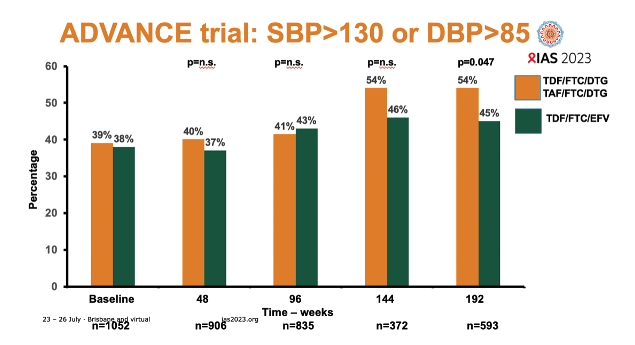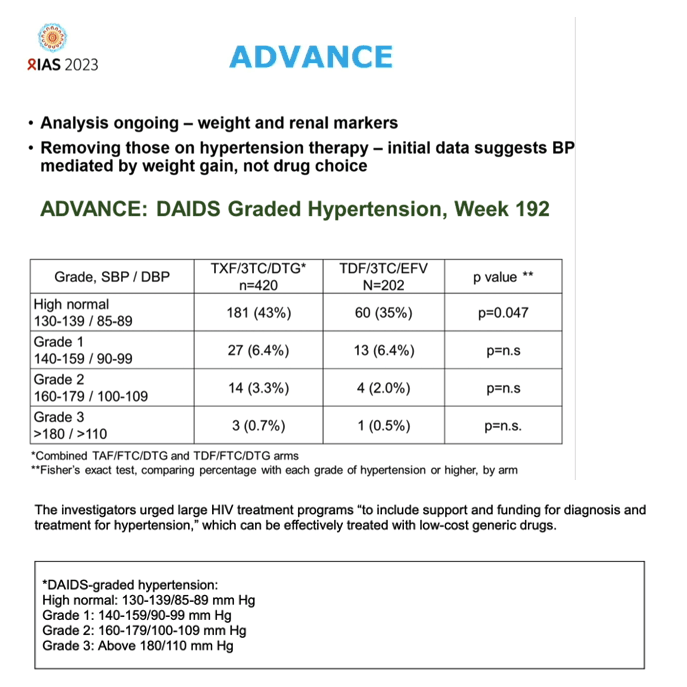 |
 |
 |
| |
Routine Hypertension Rx Nearly Erases Blood Pressure Disadvantage With DTG (mediated by weight gain)
|
| |
| |
IAS 2023, July 23-26, 2023. Brisbane
Mark Mascolini
A higher 192-week hypertension rate with dolutegravir (DTG) than efavirenz (EFV) in the Cameroon NAMSAL trial almost disappeared after 192 weeks in the South African ADVANCE trial, which featured routine treatment of hypertension [1]. The NAMSAL trial did not call for routine high blood pressure screening and treatment. Because low-co HIV treatment programs to support routine diagnosis and treatment of high blood pressure.
Antiretroviral regimens including DTG and tenofovir alafenamide (TAF) boost obesity risk more than combinations including EFV and tenofovir disoproxil (TDF), noted researchers who conducted the ADVANCE/NAMSAL comparison. Because obesity can lead to hypertension and other comorbidities, starting antiretroviral therapy with a combination less likely to promote obesity could play a key role in limiting hypertension, which remains sporadically monitored and treated in sub-Saharan Africa.
NAMSAL randomized 613 antiretroviral-naive people in Cameroon to start DTG plus TDF/lamivudine (3TC) or single-pill EFV/TDF/3TC (EFV dose 400 mg daily) [2]. Participants had their blood pressure measured at every visit through 192 weeks, but the trial did not offer routine hypertension therapy. ADVANCE enrolled 1053 South Africans previously untreated for HIV and randomized them to DTG plus TAF/emtricitabine (FTC), DTG plus TDF/FTC, or single-pill EFV/TDF/FTC (EFV dose 600 mg daily) [3]. Health workers measured blood pressure at every study visit through 192 weeks and routinely treated blood pressure above 140/90 mm Hg that developed during treatment.
NAMSAL participants had a somewhat older median age than ADVANCE participants (about 37 vs 32), and NAMSAL included a slightly higher proportion of women (about 66% vs 59%). Median body mass index was similar in NAMSAL and ADVANCE (23 and 24 kg/m2), and almost everyone in both trials was black. The NAMSAL group had a somewhat lower starting CD4 count than did the ADVANCE group (about 280 vs about 335). Two thirds of NAMSAL enrollees had a starting HIV load above 100,000 copies, compared with about one quarter of people in ADVANCE.
In NAMSAL weight through 192 weeks rose about 9 kg from baseline in women taking DTG versus about 5.5 kg in women taking EFV. Among men weight at week 192 jumped about 9 kg from baseline with DTG and 4 kg with EFV. After 192 weeks in ADVANCE weight in women climbed an average of about 10 kg with TAF/FTC/DTG, 6 kg with TDF/FTC/DTG, and 5 kg with TDF/FTC plus EFV. In ADVANCE men, 192-week gains with those three combinations averaged about 7 kg, 5 kg, and 1 kg.
Through 192 weeks in NAMSAL, average systolic blood pressure lay 6.5 mm Hg higher with the DTG combination than with the EFV regimen, climbing about 10 mm Hg versus 3.5 mm Hg, a significant difference (P < 0.01). After 192 weeks in ADVANCE, average systolic blood pressure crept up by about 1 to 2 kg with no significant difference between regimens. (ADVANCE routinely treated high blood pressure and NAMSAL did not.)
By study week 144 in NAMSAL, significantly higher proportions randomized to DTG than to EFV had systolic blood pressure above 140 mm Hg or diastolic pressure above 90 mm Hg (25% vs 12%, P = 0.001). That significant difference persisted to week 192 of NAMSAL (31% vs 19%, P = 0.002). Comparing the DTG combination to the EFV regimen at week 192, researchers charted significantly higher rates of DAIDS-defined grade 1* hypertension (18% vs 13%, P = 0.002), grade 2* hypertension (8% vs 6%, P = 0.016), and grade 3* hypertension (7% vs 2%, P = 0.004) with the DTG-containing combo.
In ADVANCE treatment-emergent grade 1 hypertension arose by week 192 in significantly more people randomized to TAF/FTC/DTG than to TDF/FTC/EFV (13% vs 8%, P = 0.038). New hypertension arose in 11% taking TDF/FTC/DTG. Everyone taking TAF/FTC/DTG with treatment-emergent hypertension got antihypertensive therapy, compared with 88% of people with new hypertension in the TDF/FTC/EFV group and 91% in the TDF/FTC/DTG arm.
In the ADVANCE trial proportions of people with a systolic blood pressure above 130 mm Hg or a diastolic pressure above 85 mm Hg stood at 39% in those assigned a DTG regimen at baseline and 38% in those assigned to the EFV regimen. At 96 weeks those proportions were 41% with a DTG regimen and 43% with the EFV regimen, a nonsignificant difference. At 192 weeks 54% taking a DTG regimen versus 45% taking the EFV regimen had high blood pressure defined by these cutoffs, a barely significant difference (P = 0.047). At 192 weeks 43% in the DTG arms versus 35% in the EFV arm had DAIDS-graded high normal hypertension (130-139/85-89 mm Hg), another difference just clearing the significance threshold (P = 0.047). The two DTG arms did not differ significantly from the EFV arm in week-192 rates of new grade 1, 2, or 3 hypertension.


References
1. Venter WDF, Sokhela S, Bosch B, et al. Risks of hypertension with first-line dolutegravir and tenofovir alafenamide in the NAMSAL and ADVANCE trials. IAS 2023, July 23-26, 2023. Brisbane.
2. NAMSAL ANRS 122313 Study Group. Dolutegravir-based or low-dose regimen for the treatment of HIV-1. N Engl J Med. 2019;381:816-826.. DOI 10.1056/NEJMoa1904340. https://www.nejm.org/doi/full/10.1056/NEJMoa1904340
3. Venter WDF, Moorhouse M, Sokhela S, et al. Dolutegravir plus two different prodrugs of tenofovir to treat HIV. N Engl J Med. 2019;381:803-815. DOI 10.1056/NEJMoa1902824.
|
| |
|
 |
 |
|
|